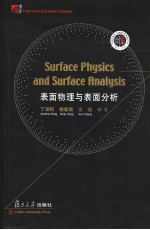

表面物理与表面分析PDF电子书下载
- 电子书积分:11 积分如何计算积分?
- 作 者:丁训民,杨新菊,王讯编著
- 出 版 社:上海:复旦大学出版社
- 出版年份:2004
- ISBN:7309041682
- 页数:279 页
Chapter 1 Introduction 1
1.1 Characteristics of Surface 1
1.1.1 Unique Characteristics of Surface 2
1.1.2 The Subjects of Surface Physics 4
1.2 Methodology of Surface Science 7
1.2.1 General Idea 7
1.2.2 Category of Surface analytical Technologies 10
1.3 Electron Spectroscopy 12
1.3.1 Energy Distribution of Secondary Electrons 12
1.3.2 Mean Free Path and Surface Sensitivity 13
1.4 Surface Cleaning Processes 16
1.4.1 Clean Surface versus Native Surface 16
1.4.2 Methods of Preparing Clean Surfaces 17
Chapter 2 Surface Atomic Structures 20
2.1 Two Dimensional Crystallography 21
2.1.1 Periodicity and Symmetry of Surface Unit Cell 21
2.1.2 Point Group and Plane Group 23
2.1.3 Nomenclature of Surface Structures 25
2.1.4 Reciprocal Lattice 28
2.2 Atomic Structures of Ideal Surfaces 30
2.2.1 Surface Structures of Metals 30
2.2.2 Surfaces of Crystalline Compounds and Alloys 34
2.3 Surface Relaxation and Reconstruction 35
2.3.1 Surface Relaxation 35
2.3.2 Surface reconstruction 39
2.4 Surface Defects 50
2.4.1 Point Defects 51
2.4.2 Dislocations 52
2.4.3 Atomic Steps 53
Chapter 3 Low Energy Electron Diffraction and Reflection High Energy Electron Diffraction 57
3.1 Principles 58
3.1.1 Brief of the Diffraction in Three Dimensions 59
3.1.2 Electron Diffraction in Two Dimensions 62
3.2 Apparatus 64
3.2.1 LEED Optics 64
3.2.2 Spot Profile Analysis LEED 66
3.2.3 Measurement of Ⅰ-Ⅴ Curves 68
3.2.4 Shield and Compensation of Stray Electromagnetic Field 69
3.3 Pattern Recognition 70
3.3.1 Diffraction Orders 70
3.3.2 Pattern Transform 72
3.3.3 LEED Patterns of Stepped Surfaces 75
3.4 LEED Ⅰ-Ⅴ 79
3.4.1 Experimental and Theoretical Ⅰ-Ⅴ Curves 79
3.4.2 R Factor 81
3.5 Reflection High Energy Electron Diffraction 85
3.5.1 Principle 85
3.5.2 RHEED Analysis 88
3.5.3 RHEED Intensity Oscillation 92
3.6 Appendix 94
3.6.1 Compilation of LEED Patterns 94
3.6.2 Compilation of RHEED Patterns 102
Chapter 4 Scanning Probe Microscopy 107
4.1 General Concept 108
4.2 Scanning Tunneling Microscopy 110
4.2.1 Basic Principle 110
4.2.2 Apparatus 112
4.2.3 Working Modes and Conditions 117
4.2.4 STM Imaging 119
4.2.5 Scanning Tunneling Spectroscopy 123
4.2.6 STM Nanofabrication and Atom Manipulation 125
4.3 Atomic Force Microscopy 127
4.3.1 Principle 127
4.3.2 Apparatus 130
4.3.3 Working Modes ofAFM 134
4.3.4 Lateral Force Microscopy 138
4.4 Other Types of Scanning Probe Microscopy 140
4.4.1 Scanning Magnetic Force Microscopy 140
4.4.2 Scanning Near-field Optical Microscopy 142
4.4.3 Ballistic Electron Emission Microscopy 145
Chapter 5 Surface Electronic States 149
5.1 Existence of Localized Electronic States at Surfaces 149
5.1.1 Bulk States and Surface States 149
5.1.2 Surface States in One-dimensional Models 152
5.2 Surface Dangling Bond States 158
5.2.1 Dangling Bond and Its Hybrid 158
5.2.2 Dangling Bond States at Reconstructed Surfaces 160
5.2.3 Dangling Bond States and Fermi Level Pinning 163
5.3 Adsorbate Induced Electronic States 164
5.3.1 Adsorption Phenomena 165
5.3.2 Adsorbate-induced Work Function Changes 169
5.3.3 Metal-induced Gap States(MIGS) 173
Chapter 6 Auger Electron Spectroscopy 175
6.1 Principle 176
6.1.1 Auger Process 176
6.1.2 Energy of Auger Electron 178
6.1.3 Yield and Cross-section 180
6.1.4 Differential Spectra and Count Spectra 181
6.2 Apparatus and Experimental Methods 183
6.2.1 Experimental Setup 183
6.2.2 Experimental Conditions 186
6.3 Qualitative and Quantitative Analysis 189
6.3.1 Element Identification 189
6.3.2 Quantitative Composition Analysis 190
6.3.3 Chemical Analysis 193
6.4 Depth Profiling 194
6.4.1 Purpose and Methods 194
6.4.2 Profile ofCompositions 196
6.4.3 Interface Location 198
6.5 Scanning Auger Microscopy 201
6.5.1 Line-scan 202
6.5.2 Auger Map 202
6.5.3 Spatial Resolution 203
Chapter 7 X-ray Photoelectron Spectroscopy 205
7.1 Principle 206
7.1.1 Three Step Process of Photoemission 206
7.1.2 Binding Energy 208
7.2 Apparatus 209
7.2.1 X-ray Sources 210
7.2.2 Electron Energy Analyzer 213
7.2.3 Detectors 215
7.3 Qualitative Analysis 215
7.3.1 Energy Calibration 215
7.3.2 Peak Discrimination 217
7.3.3 Element Identification 222
7.4 Quantitative Analysis 223
7.4.1 Quantification Methods 223
7.4.2 Background Subtraction 224
7.4.3 Peak Decomposition 226
7.4.4 Depth Profile and Depth Information 229
7.5 Chemical States Studies 231
7.5.1 Chemical Shift 231
7.5.2 Charging Effect and Compensation 233
7.6 Appendix-Electron binding energies of elements in periodic table 235
Chapter 8 Ultra-Violet Photoelectron Spectroscopy 240
8.1 Principle 240
8.1.1 UPS versus XPS 240
8.1.2 Basic Process 241
8.1.3 Selection Rules and Wavefunction Symmetry 245
8.2 Light Sources 246
8.2.1 Discharge Lamp 246
8.2.2 Monochromator and Polarizer 248
8.2.3 Special Synchrotron Radiation Sources 251
8.3 Applications 254
8.3.1 Identification of Surface Electronic States 254
8.3.2 Mapping of Surface and Bulk Bands 258
8.3.3 Identification of Adsorbates:Species and Adsorption Sites 263
References 268
Index 274
- 《水面舰艇编队作战运筹分析》谭安胜著 2009
- 《分析化学》陈怀侠主编 2019
- 《影响葡萄和葡萄酒中酚类特征的因素分析》朱磊 2019
- 《仪器分析技术 第2版》曹国庆 2018
- 《新编高中物理竞赛教程习题全解》钟小平主编;钟小平,倪国富,曹海奇编写 2019
- 《数学物理方法与仿真 第3版》杨华军 2020
- 《全国普通高等中医药院校药学类专业十三五规划教材 第二轮规划教材 分析化学实验 第2版》池玉梅 2018
- 《中学物理奥赛辅导:热学 光学 近代物理学》崔宏滨 2012
- 《Power BI数据清洗与可视化交互式分析》陈剑 2020
- 《长江口物理、化学与生态环境调查图集》于非 2019
- 《市政工程基础》杨岚编著 2009
- 《家畜百宝 猪、牛、羊、鸡的综合利用》山西省商业厅组织技术处编著 1959
- 《《道德经》200句》崇贤书院编著 2018
- 《高级英语阅读与听说教程》刘秀梅编著 2019
- 《计算机网络与通信基础》谢雨飞,田启川编著 2019
- 《看图自学吉他弹唱教程》陈飞编著 2019
- 《法语词汇认知联想记忆法》刘莲编著 2020
- 《培智学校义务教育实验教科书教师教学用书 生活适应 二年级 上》人民教育出版社,课程教材研究所,特殊教育课程教材研究中心编著 2019
- 《国家社科基金项目申报规范 技巧与案例 第3版 2020》文传浩,夏宇编著 2019
- 《流体力学》张扬军,彭杰,诸葛伟林编著 2019
